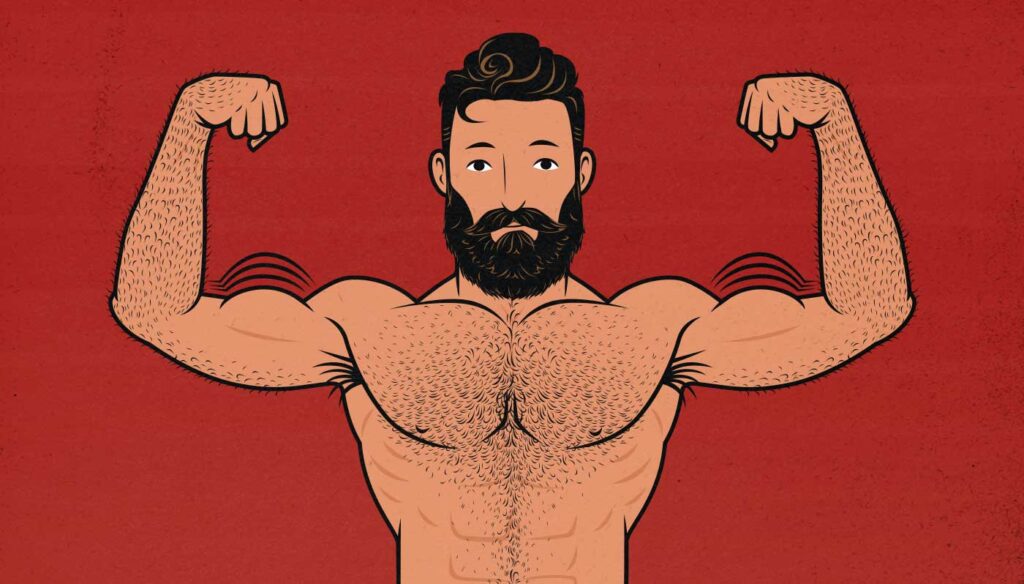
How to Build Bigger Biceps
Our biceps aren’t big muscles. They’re a mere fraction of the size of our quads, glutes, shoulders, and chests. But they’re disproportionately prominent. Building bigger biceps can make us look much stronger. And with good reason. Our biceps play a large role in our general strength.
There’s an old strength training adage, though, telling us that all we need to build bigger biceps is to get stronger at compound lifts—at chin-ups and rows. That’s not quite the case, and perhaps that’s why most people’s biceps lag behind. We don’t train them directly enough, hard enough, or often enough.
So, what’s the best way to build bigger biceps?
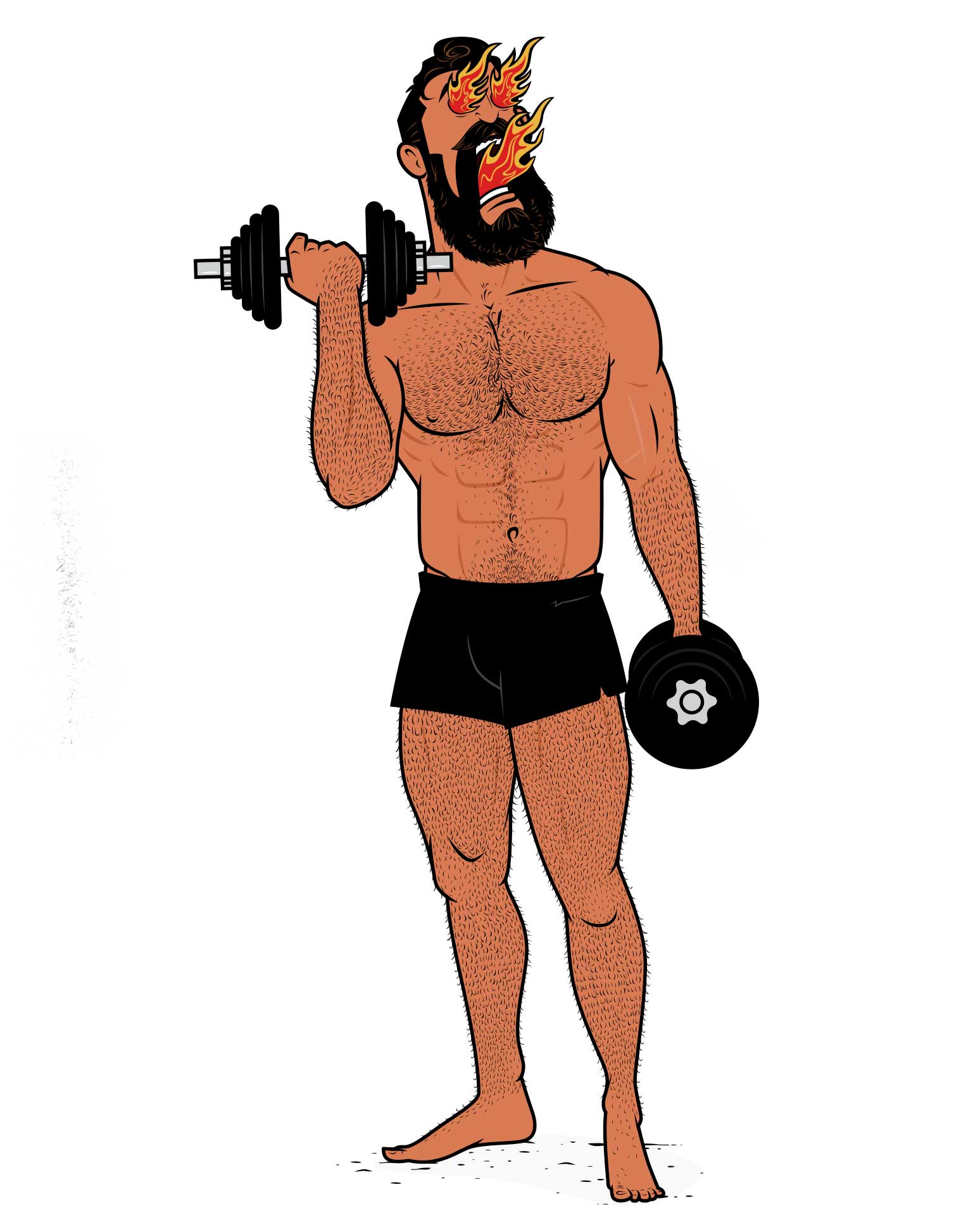
How to Train Your Biceps
The first step to building bigger biceps is to understand what you use them for and which other muscles have similar functions. That way, you can understand which lifts work your biceps best.
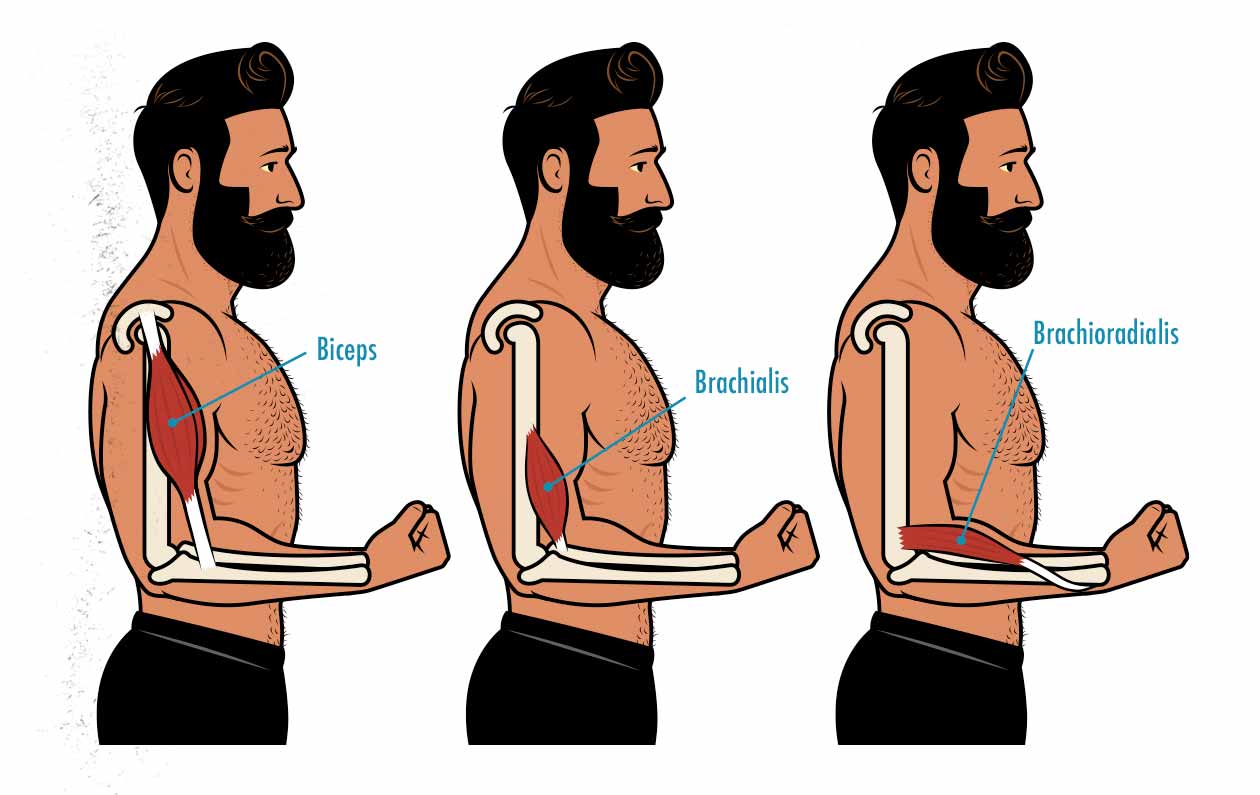
There are three main arm muscles involved in pulling and curling movements: the biceps, brachialis, and brachioradialis. All of them engage to a certain degree in most pulling lifts, but they each have their different specialties, and so depending on which lifts you choose and how you perform them, you can stimulate muscle growth in different areas.
Training the Biceps
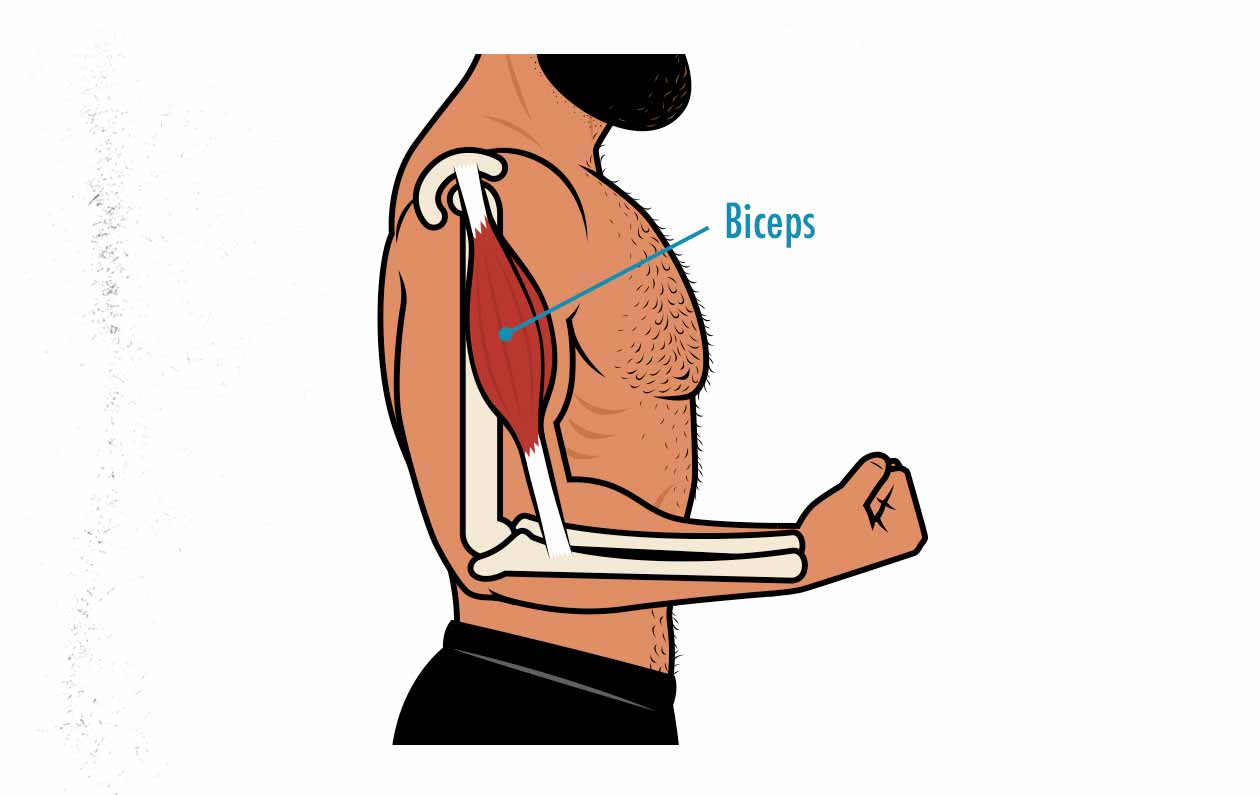
Biceps Anatomy
Our biceps are the big, bulging muscles in your upper arms. They’re famous for helping you flex your arms, and they’re strongest when you use an underhand (supinated) grip. But it’s not quite so simple.
Your biceps also cross the shoulder joint. They stretch deeper when you bring your elbows behind your body and get a fuller contraction when you bring your elbows in front of your body:
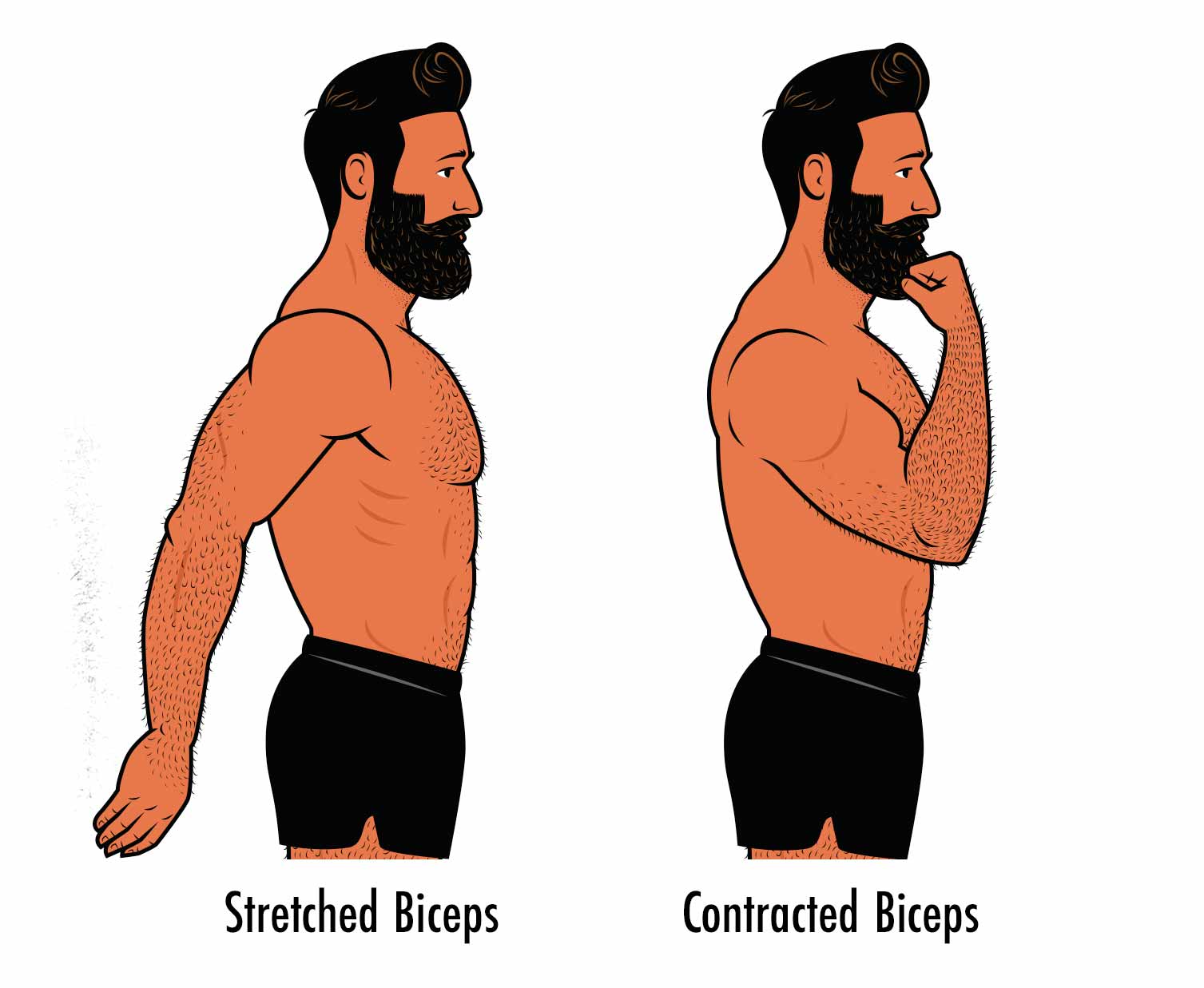
This movement at the shoulder joint has a few implications for how we should train our biceps, including a controversial one. But let’s start with the less controversial part: to get a full contraction of your biceps, you need to bring your elbows forward. That’s why you’ll see some people bringing their elbows forward a little bit at the top of a biceps curl, like so:
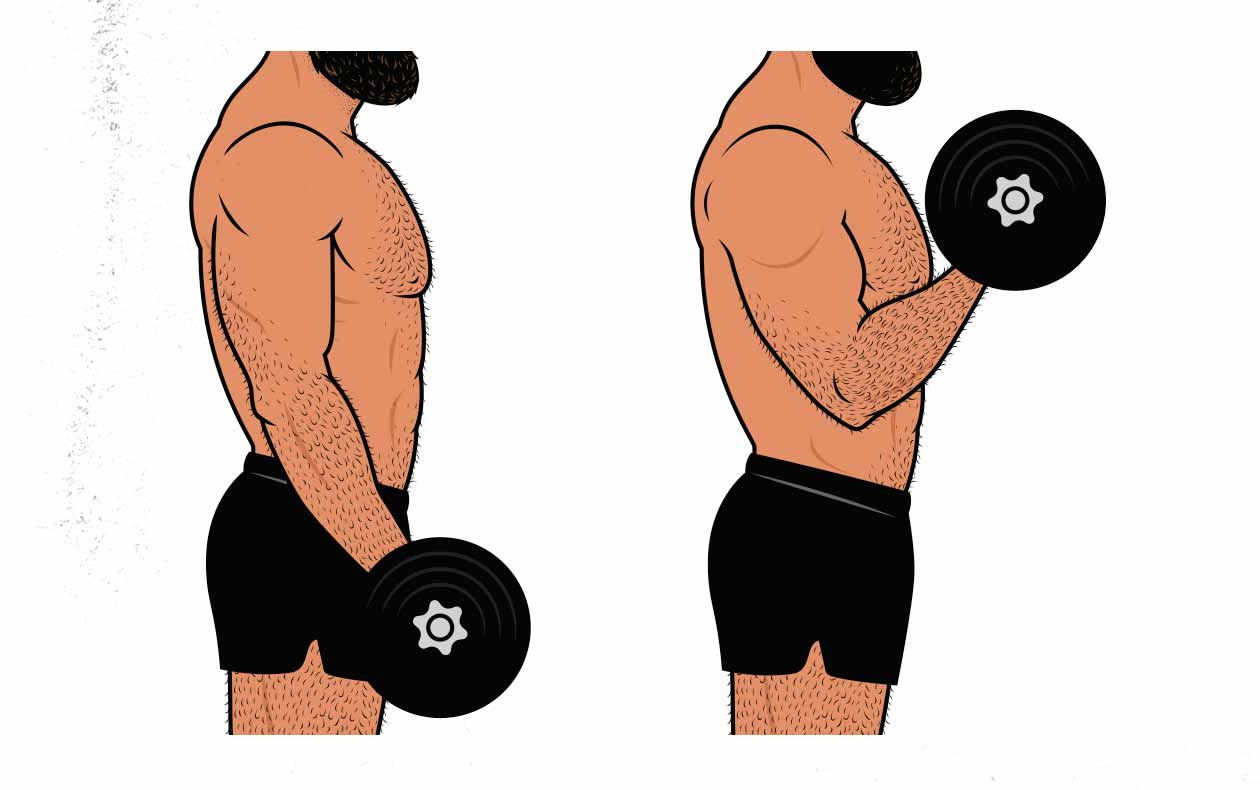
This movement at the elbows works your biceps through a larger range of motion. That’s typically considered a good thing. In this case, it doesn’t matter.
Biceps Range of Motion
Our muscles grow best when we challenge them at longer muscle lengths, so it makes more sense to focus on fully extending our arms at the bottom of the biceps curl, not trying to get a full contraction at the top (study, study).
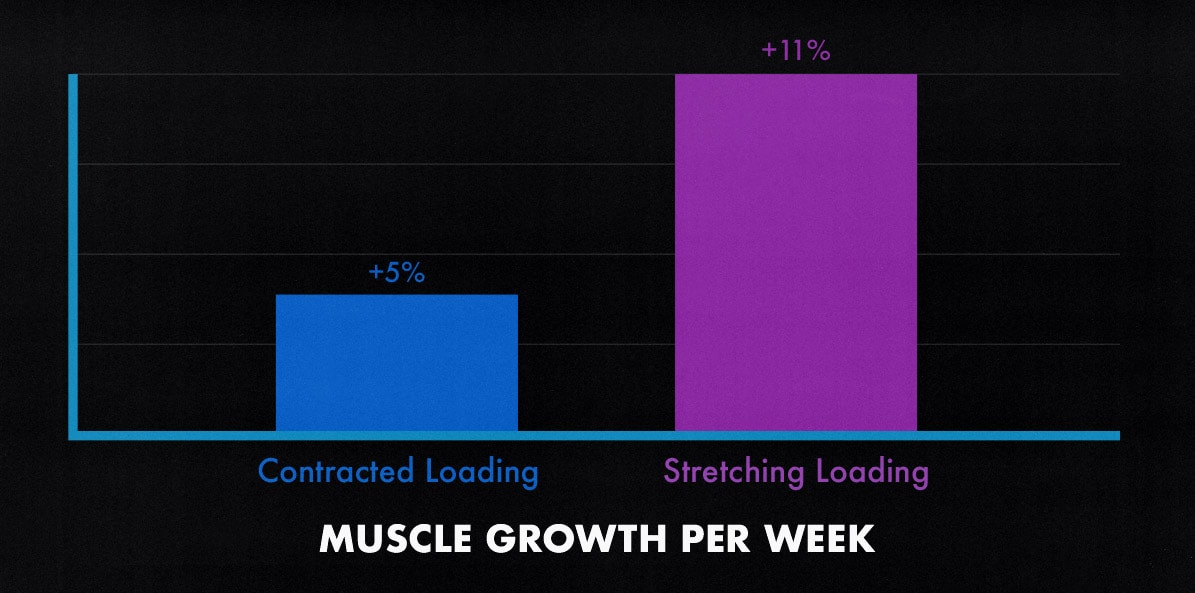
You can keep your elbows pinned to your sides or let them drift forward as you curl. It won’t have much impact on muscle growth. Technically speaking, though, if you want a full biceps contraction, then you’d curl the weight all the way to your chin.
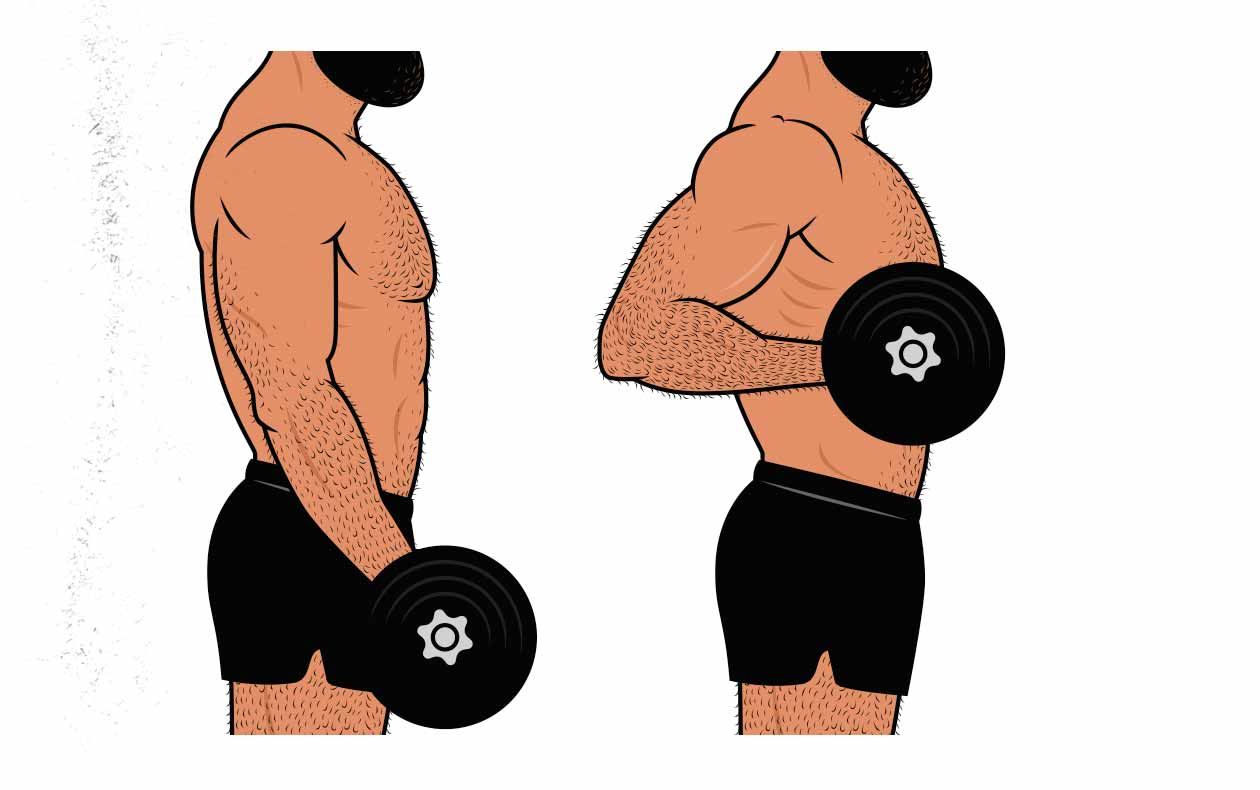
Movement at the shoulder joint can be a problem, though. If you let your elbows drift backwards while curling. For a simple example, consider the drag curl (shown above). When you flex your arms while moving your elbows back, you’re asking your biceps to contract to lift the weight up and asking them to relax so that you can move your elbow backward. That’s not good.
That doesn’t mean that drag curls are useless. When the long head of your biceps isn’t able to properly engage, it puts more load on the short head. If that’s what you’re trying to do, great. But if you’re trying to build bigger biceps overall, it’s usually better to keep your elbows pinned or to let them drift forward.
The Problem With Pulling Exercises
Here’s where it gets controversial. Almost every compound pulling movement looks quite a lot like a drag curl! When you do chin-ups or rows, you pull your elbows back:
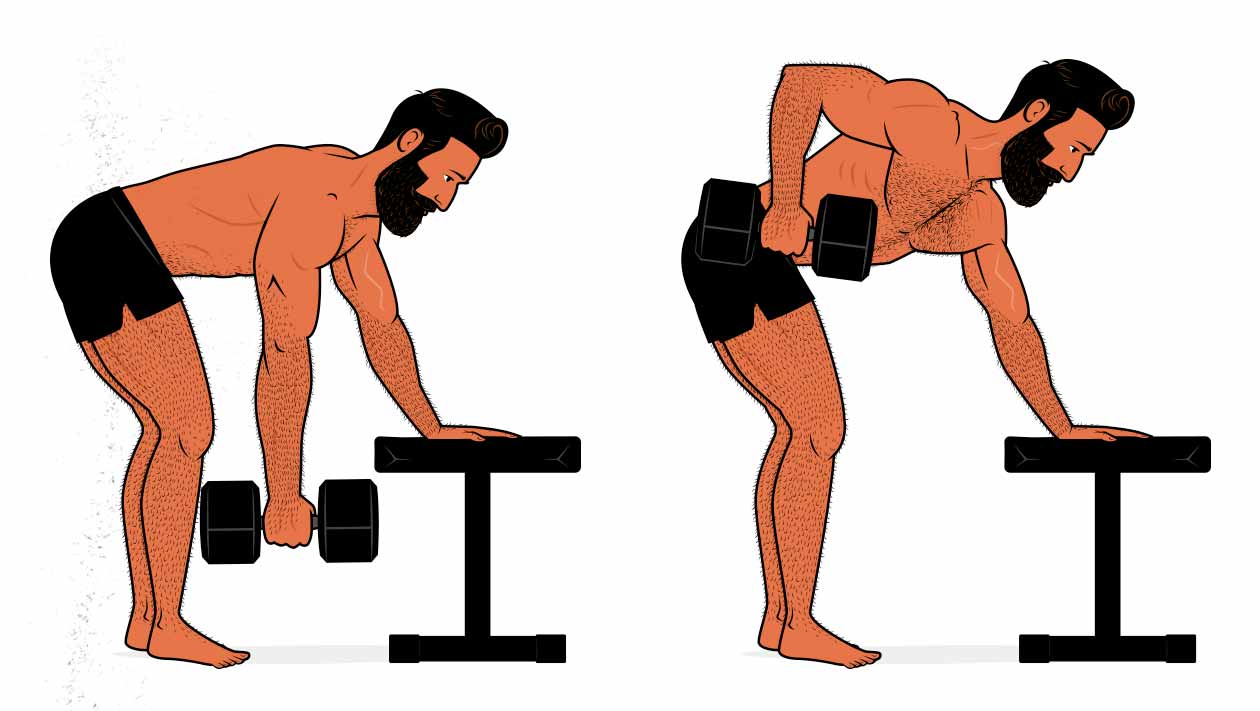
In a study by Mannarino and colleagues, dumbbell curls resulted in nearly twice as much biceps growth per set as dumbbell rows, even though the participants did the rows with an underhand grip and an intentional emphasis on their biceps (study):
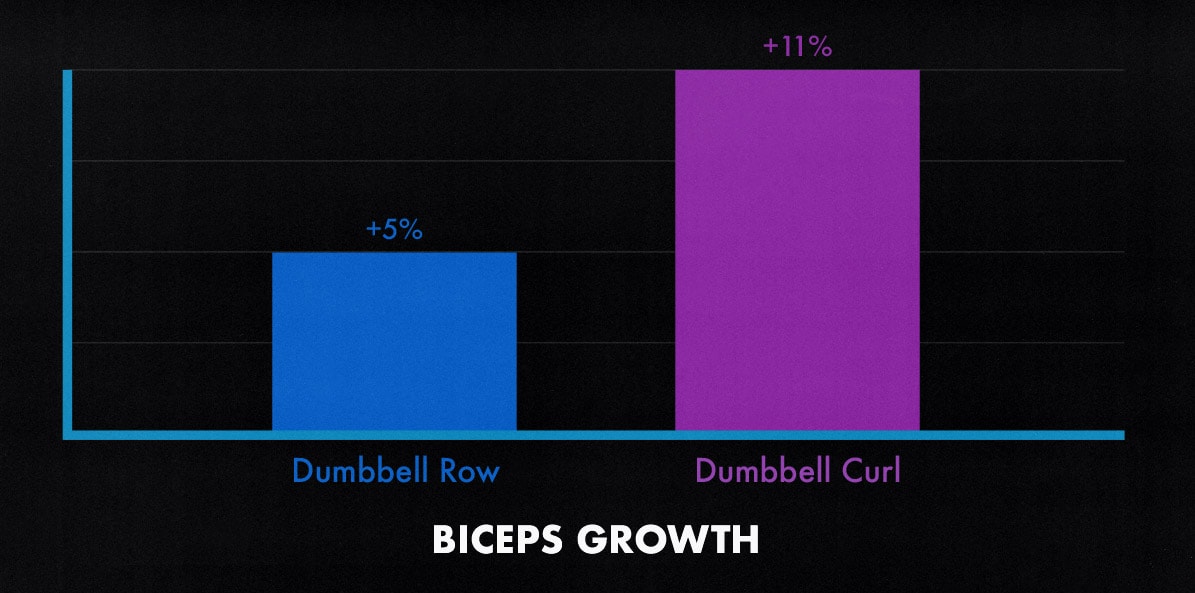
To be fair, there’s more to it than movement at the elbow joint. When you do compound lifts, there are several different muscles that can be your limiting factor. For example, if your lats fail before your biceps when doing chin-ups, your biceps might not be challenged enough to stimulate a maximal amount of muscle growth.
Still, even just the dynamics of pulling movements aren’t ideal. When training for biceps growth, it’s best to include lifts that work your biceps in a more natural, rigorous way—biceps curls.
Training the Brachialis
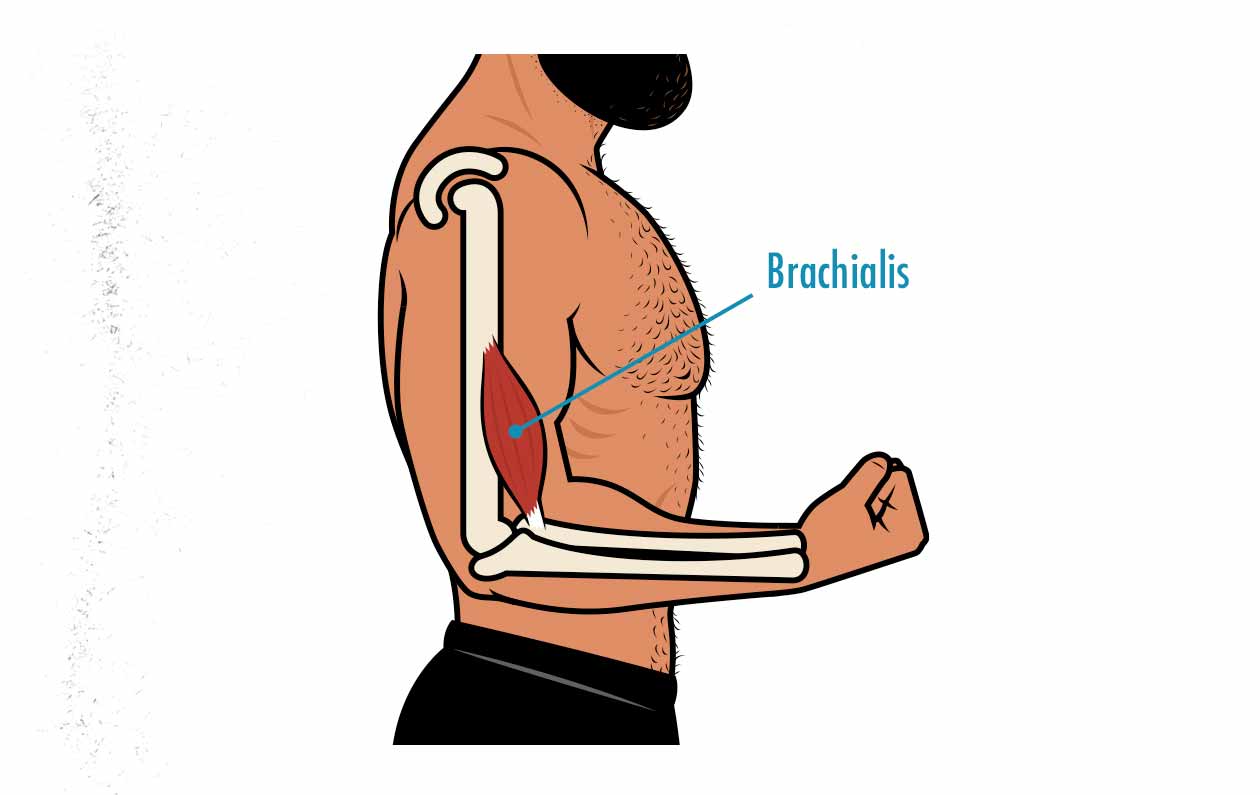
Okay, next up we have the brachialis. They aren’t as big as your biceps, and since they sit underneath, you won’t see them directly unless you’re at like 5% body fat. Still, the bigger you build your brachialis, the thicker your arms will get, and the bigger your biceps will look. The brachialis muscles work hardest when we use a neutral grip, so to train them, we can do lifts like hammer curls:
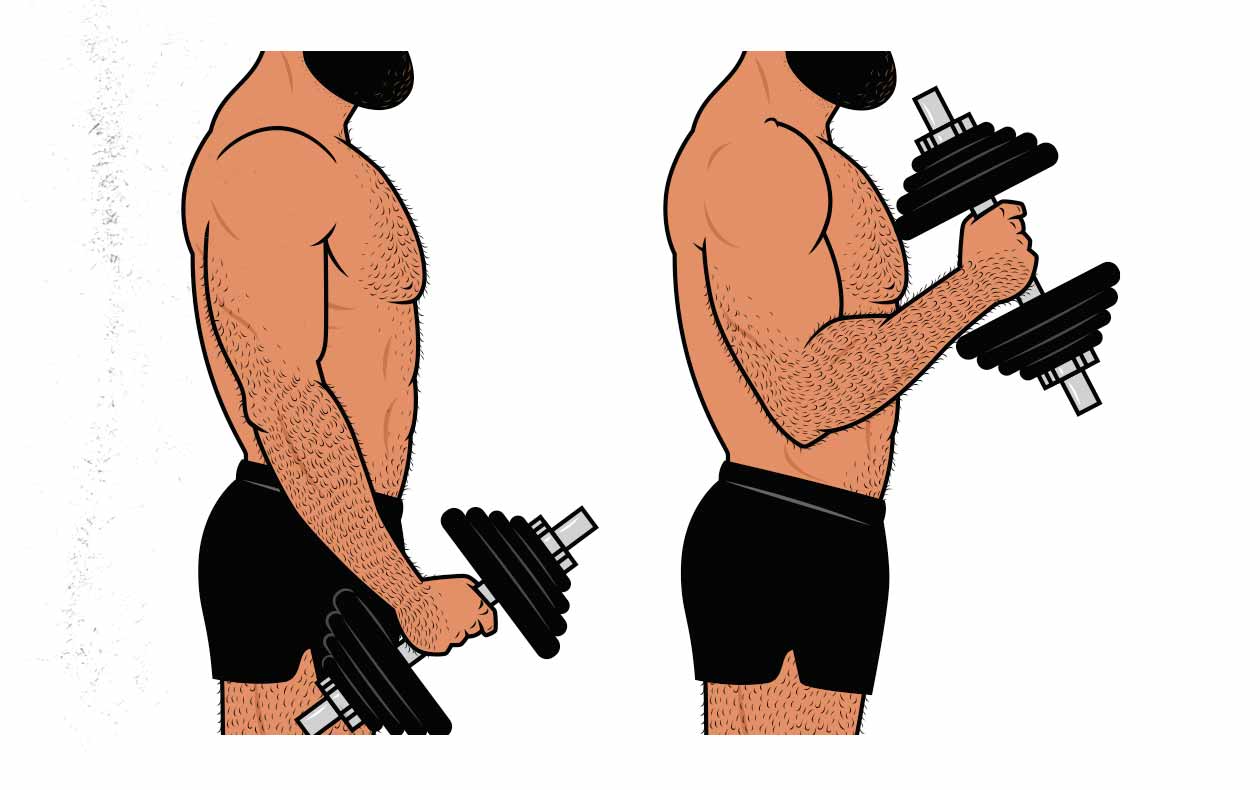
The other thing that makes the brachialis different from the biceps is that they don’t cross the shoulder joint, allowing them to fully engage even when you’re pulling your elbows back. That makes your brachialis extremely useful in compound lifts. In fact, if you’re doing plenty of compound pulling lifts (such as chin-ups and rows), your brachialis muscles may get so much work that you don’t even need any hammer curls in your routine.
Training the Brachioradialis
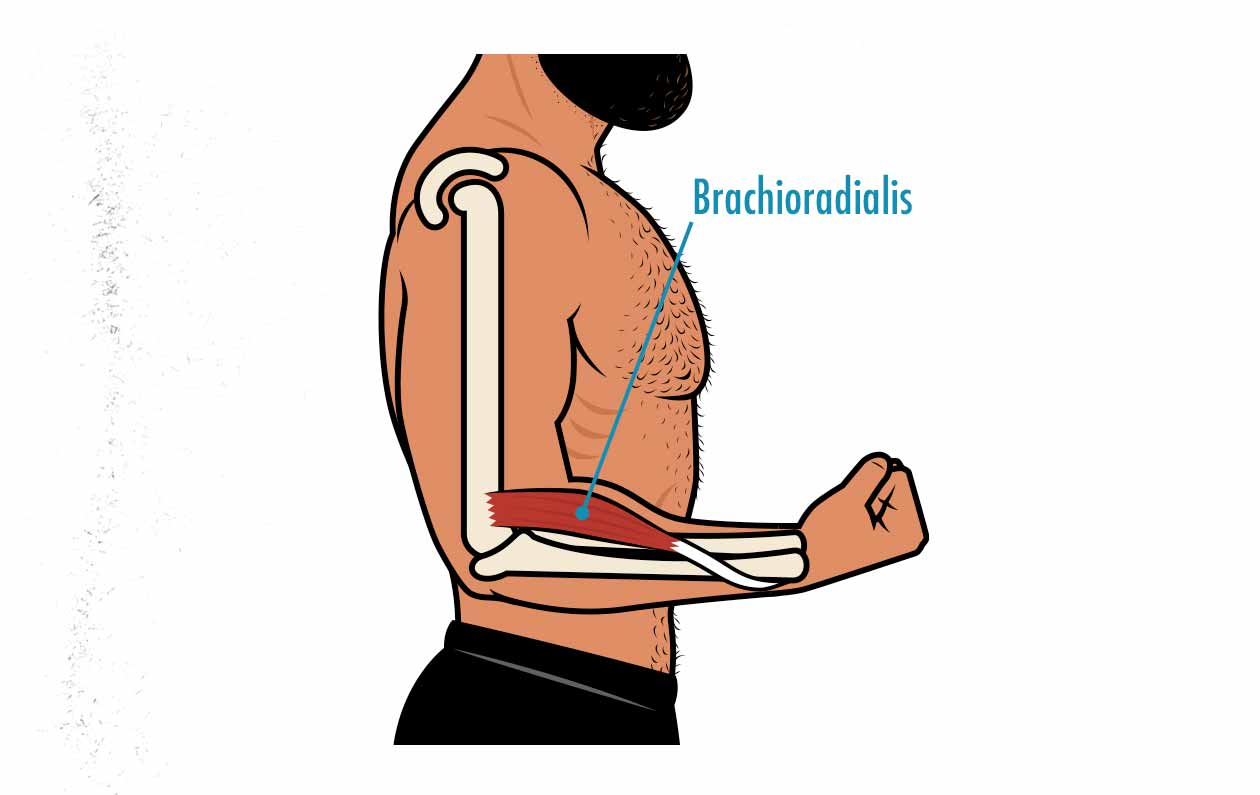
Finally, there’s the brachioradialis, one of the beefier forearm muscles. Like your biceps and brachialis muscles, they help to flex your arms, but if you look at the above illustration, you’ll notice that the brachioradialis wraps around and attaches to the bones on the backside of your forearms. To give your brachioradialis proper leverage, then, you need to twist your grip around, as in the reverse curl:
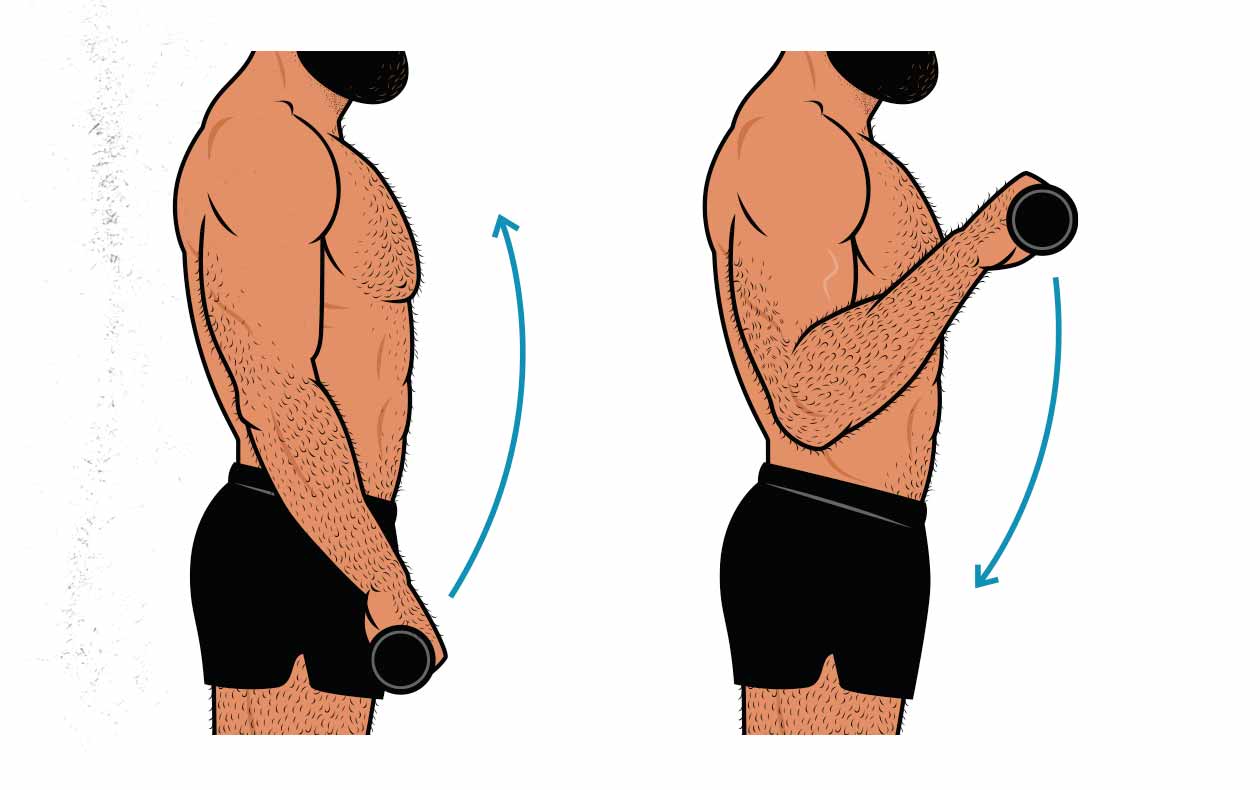
Fortunately, if you’re already doing barbell rows or pull-ups, your brachioradialis muscles are already doing plenty of work. You may still want to include some reverse curls, especially if your forearms are lagging behind, but a balanced hypertrophy program doesn’t need to include them.
The Best Biceps Exercises
The best biceps exercises are those that fully engage your biceps, use a deep range of motion, and allow you to move a lot of weight. Two movements are great for that:
- The chin-up is the heaviest biceps lift, and as a bonus, it also works most of the muscles in our upper backs. The only problem is that we need to pull our elbows back, preventing the long heads of our biceps from fully engaging. It’s not a deep range of motion.
- The biceps curl is the best lift for isolating the biceps. It allows you to flex at both the elbow and shoulder joints. Plus, when you curl the weight up, your elbows will want to drift back, putting extra stress on the long head of your biceps. When combined with chin-ups, they’ll give you a well-rounded biceps routine.
There are plenty of different chin-up and biceps curl variations, though, so let’s talk about the pros and cons of each, as well as how to do them.
The Chin-Up
As we covered above, several different muscles can flex your upper arms. Your biceps bear the brunt of the load when you use an underhand grip, a neutral grip engages a pleasant mix of muscles, and your brachialis and brachioradialis take over when you use an overhand grip.
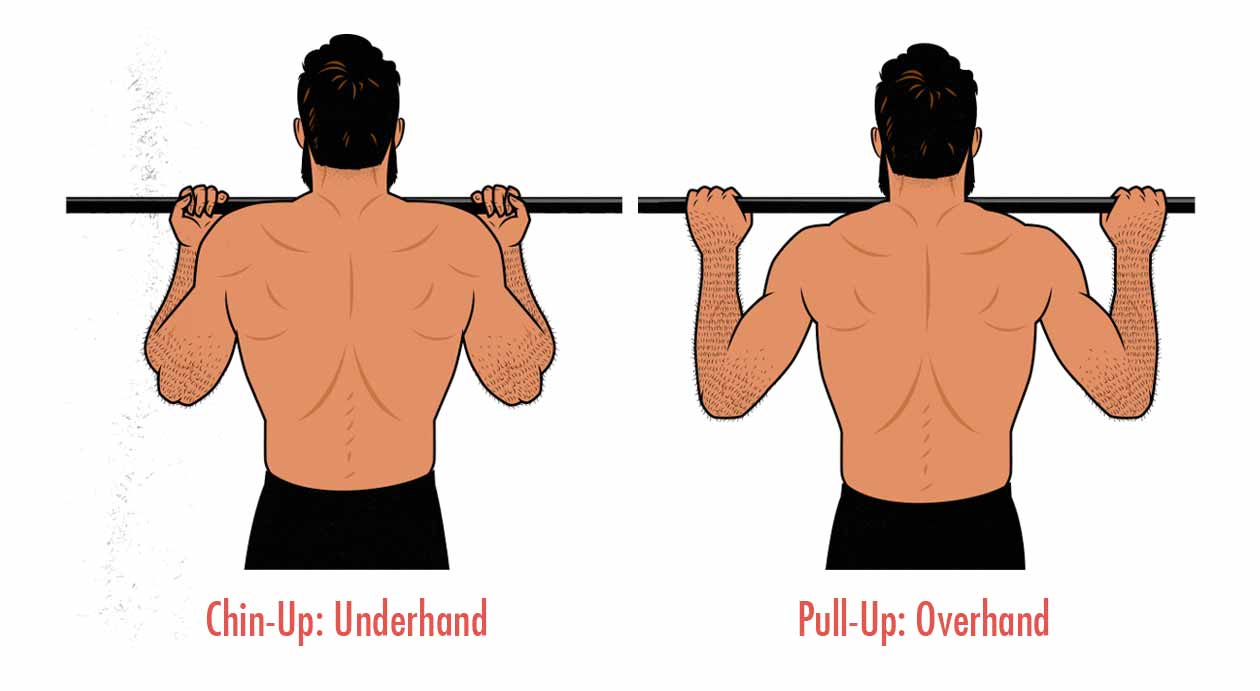
As a result, chin-ups (underhand or neutral grip) are better than pull-ups (overhand grip) for building bigger biceps. Pull-ups are still a good exercise, but because they don’t engage your biceps much, most people aren’t as strong at them. The range of motion is smaller, too. So even for our upper-back muscles, chin-ups are often the better choice.
However, there are a few different types of chin-ups. The classic chin-up is done on a straight bar, as shown in the illustrations. But some people find that using slightly angled bars is easier on their elbows. That’s perfectly fine. With an angled bar, your biceps will still fully engage, and as a bonus, you might get some extra help from your brachialis. Gymnastics rings are great, too. Even neutral-grip chin-ups, with your palms facing one another, are fantastic.
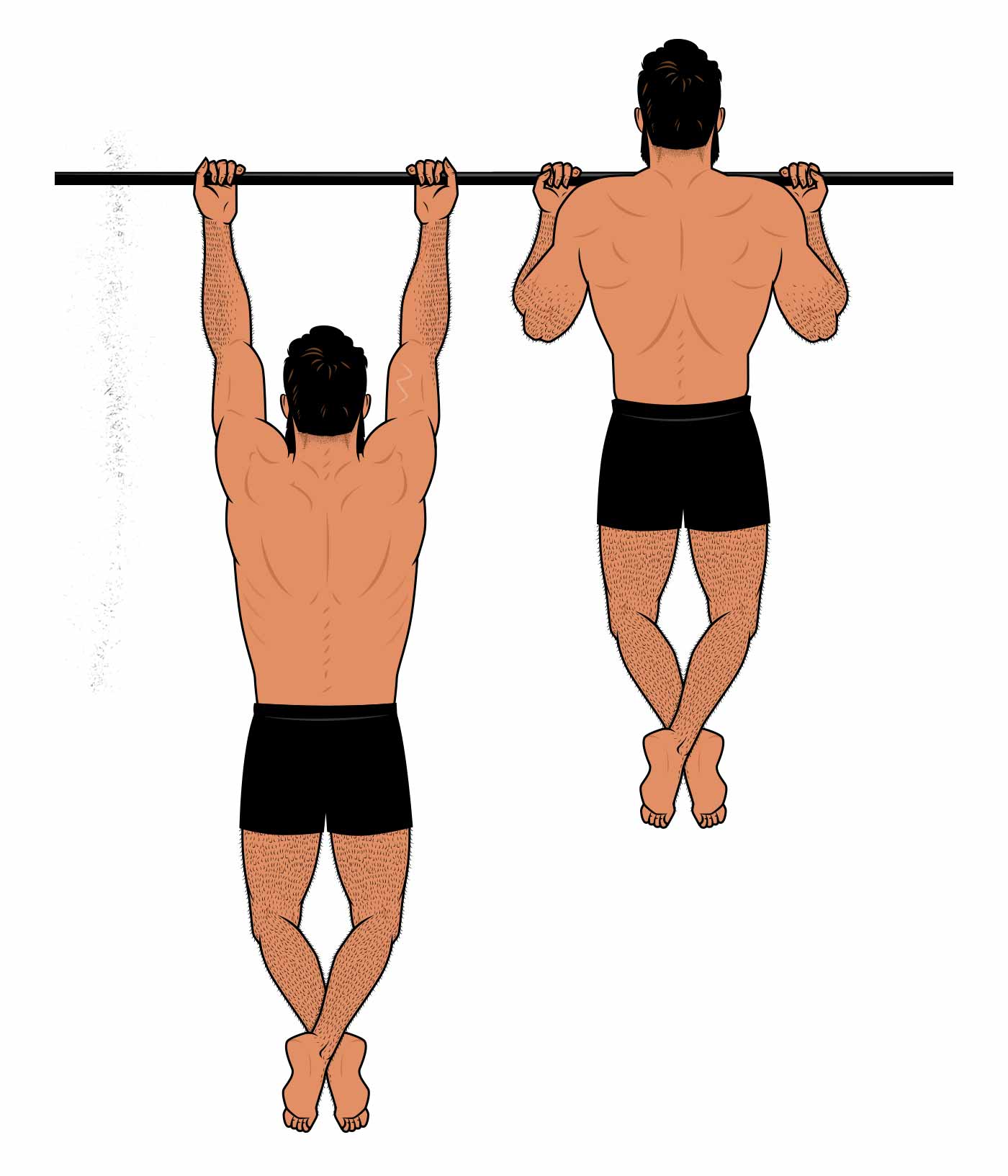
The final thing to consider is the range of motion. Ideally, you want to lower yourself down to a dead hang at the bottom, then pull your chest all the way to the bar. This won’t stretch your biceps, though. In fact, the extra movement at the shoulder joint shortens them. The benefit of doing deep chin-ups is to stretch out your upper back muscles. You’re using this as a heavy compound lift.
The Biceps Curl
Biceps curls are the king of biceps exercises. Because there’s no interference from the shoulder joint, and because the biceps are the limiting factor, they stimulate by far the most biceps growth. They’re also a fairly small exercise, generating less overall fatigue and requiring shorter rest times. It shouldn’t take more than 5 minutes to pop in a quick 2–3 sets of curls at the end of your workout.
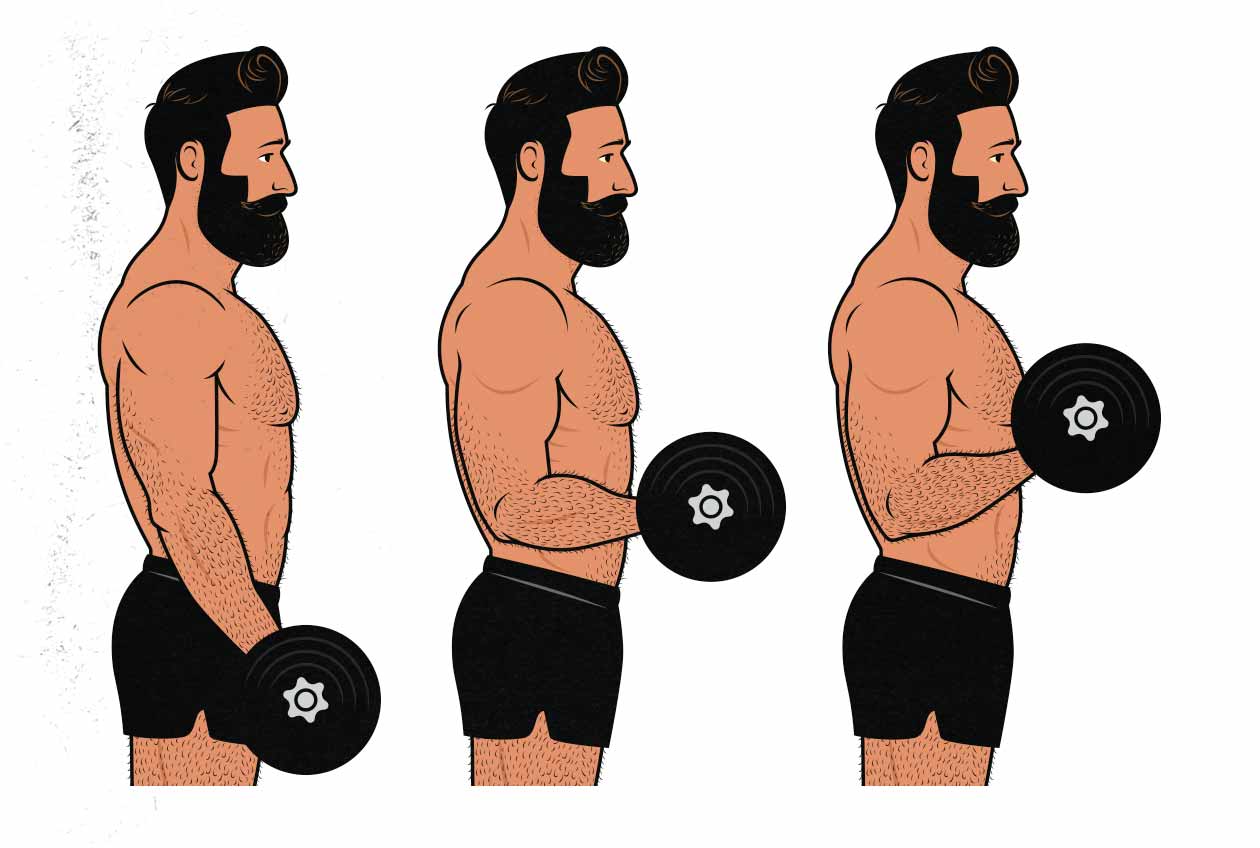
The downside to biceps curls is that they aren’t as good for developing your upper back. But you’re doing them to build bigger biceps. For that, they’re perfect.
The Best Biceps Workouts
To build a biceps workout, you’ll want to start by choosing a big compound pulling movement. That way, you can warm up your biceps, tendons, and elbow joints, start stimulating some biceps growth, and get a good upper-back workout in.
- Deadlifts (not great for your biceps, but a good first exercise).
- Rows (not great for your biceps, but good for your back and forearms).
- Chin-ups (great for your biceps and a great pulling movement).
Then, once you’ve done your compound lifts, you can do a few quick sets of biceps curls to make sure that you’ve stimulated a maximal amount of biceps growth.
- Barbell curls
- Curl-bar curls
- Dumbbell curls
- Preacher curls
- Incline curls
- Lying biceps curls
All of these exercises biceps exercises work your biceps incredibly hard. Barbell curls allow you to lift the heaviest, dumbbell curls are easiest on your joints and tendons, incline curls train your biceps under the deepest stretch, and preacher curls have a great strength curve.
All biceps curls are awesome. Pick one or two of your favourite variations, focus on getting stronger at them, and then switch them up every few weeks.
Barbell Biceps Workout
Barbells allow you to lift heavier weights, turning the biceps curl into more of a compound lift. You may find that your upper back, core, and forearms get quite tired by the end of a gruelling, heavy set. And that’s great. The humble biceps curl can be a great exercise for developing your general strength.
The downside is that barbells aren’t designed for curls, so you need to watch out for elbow and forearm tendon pain. Most people don’t have issues, but some people do, and so it pays to be proactive. If there’s no pain, no problem. But if barbell curls hurt, adjust your grip width and experiment with higher rep ranges. If that doesn’t solve it, consider getting a curl-bar, allowing you to use a more natural grip position. (Curl-bars are handy for building bigger triceps, too.)
Monday barbell biceps workout:
- Chin-Ups: 3–4 sets of As Many Repetitions As Possible (AMRAP).
- Barbell Curls: 2–3 sets of 8 repetitions.
Friday barbell biceps workout:
- Barbell Rows: 3–4 sets of 15 repetitions.*
- Barbell Curls: 2–3 sets of 12 repetitions.
*We use a higher rep range on barbell rows so that it becomes an upper-back exercise instead of a hip and lower back exercise. More on that in our article on barbell rows.
Dumbbell Biceps Workout
Barbells often make training more convenient, but that’s not really the case with your biceps. Dumbbells allow you to work your biceps through a larger range of motion and with freer movement in your wrists and elbows. As a result, you’re less likely to be bothered by cranky joints or tendons.
Monday dumbbell biceps workout:
- Chin-Ups: 3–4 sets of As Many Repetitions As Possible (AMRAP).
- Alternating Dumbbell Curls: 2–3 sets of 12 repetitions.
Friday dumbbell biceps workout:
- Dumbbell Rows: 3–4 sets of 15 repetitions.
- Incline Dumbbell Curls: 2–3 sets of 10 repetitions.
The Importance of Progressive Overload
One of my biggest mistakes when trying to bulk up my biceps was that I forgot about the importance of progressive overload. Most people approach their training with the goal of getting stronger at the big compound lifts: the squat, bench press, deadlift, overhead press, and even chin-up. And as I made progress on all of those lifts, my torso and back got much bigger. My arms did not.
By the time I had gained my first 40 pounds, my arms had gone from 10 inches to around 11.5–12 inches. That’s progress. My arms looked much better. But they were still small. And I was disappointed in how little they’d grown.
The trick is, when you have the specific goal of building bigger biceps, you need to approach your biceps curls with the same fervour as your bigger lifts. You need to work on adding weight or adding reps over time. Fight for that progress.
Where this gets tricky is with the placement of biceps curls. They typically come at the end of our workouts, and there’s good reason for that. No sense tiring out your biceps when you still have compound lifts to do, right? But if your biceps are what you’re most eager to grow, feel free to move the curls earlier in your workout when you’re still feeling fresh and strong.
When you start adding reps or weight to your biceps curls every week or two, that’s when you’ll really start to see them grow.
Frequently Asked Questions
Why Do Biceps Curls Make Your Elbows Hurt?
It’s common to get forearm or elbow pain when doing barbell curls. When your forearms hurt, you’ll hear it called forearm splints or tendinitis. This might be because of your bone structure or tendon flexibility, but it may also be that your posture is a bit wonky, that you haven’t developed the mobility you need yet, or that your tendons still need to grow a bit stronger. You might be able to come back to barbell curls later, once you’re stronger, tougher, and more mobile.
When you notice pain from doing barbell curls, it generally comes in two varieties:
- Chronic pain: comes from prolonged and intense lifting, it might be caused by small stress fractures in your bones, persistent inflammation in your tendons, or long-term aggravation of your elbows. When this happens, it can help to quit doing curls for 2–4 weeks, allowing the pain to fully subside. When you return to biceps curls, it can help to not only choose new variations and rep ranges, but also to use a lower training volume, doing just a couple sets per week. At least at first.
- Pain when doing the exercise itself (or when setting the weights down): If you’re new to biceps curls, it’s more likely that your forearm tendons are getting inflamed or you’re exceeding the range of motion that’s comfortable for your elbows (although remember that this can change). Switching to a new variation or rep range often solves this problem right away.
There are a few variations and strategies that can make biceps curls easier on your forearms and elbows:
- Do your heavy lifting first. If you start your workouts with chin-ups or rows, you’ll warm up your elbow joints using lifts that aren’t as likely to aggravate them (especially if you’re doing chin-ups with a neutral grip or gymnastics rings). You’ll also tire out your biceps, reducing the amount of weight you’ll be able to lift when you do your biceps curls. That way when you get to your biceps curls, your elbows will be warmed up and you’ll be using lighter weights.
- Do more reps per set. Following up on the first point, if heavy biceps curls are aggravating your elbows, try doing them in a higher rep range. Doing at least 8 reps per set is usually wise, and feel free to go all the way up to 20 reps.
- Use a different exercise variation. If you’re using a straight barbell, try using a curl-bar. If you’re using a curl-bar, try using dumbbells or cables.
- Try training one arm at a time. One-arm or alternating biceps curls often solve the problem, especially if the problem is rooted in poor posture.
Don’t power through the pain. Don’t tough it out. Listen to your joints and tendons. If they’re screaming out in pain, listen to those screams. Adjust what you’re doing, and then go back to building bigger biceps. These things are common. It’s not a big deal. Just don’t push through it. Adjust instead.
Should You Curl With Dumbbells, Barbells, Curl-Bars or Cables?
Biceps curls can be done with dumbbells, a barbell, a curl bar, cables, or, in a pinch, resistance bands. With all of those variations, you’re training pure elbow flexion, the range of motion is great, and your biceps will be the limiting factor. You’ll stimulate a ton of biceps growth.
The catch is, depending on how you’re built, barbell curls may aggravate your elbows or forearms. That’s why so many people prefer using dumbbells, cables, resistance bands, or the shoulder-width grip on a curl-bar (aka EZ-bar):

The advantage to doing the barbell and curl-bar biceps curls is that they’re heavier, and so they do a better job of working more overall muscle mass. Instead of being just a biceps exercise, you can get a decent upper-back and forearm workout out of them as well.
The advantage to doing dumbbell and cable biceps curls is that you can freely rotate your wrists and elbows, and you can bring your elbows further back at the bottom without the barbell colliding with your torso. That makes the biceps curls easier on your joints and harder on your biceps, which is perfect. Think of variations like the dumbbell incline curl or the bayesian cable curl, where you stretch your biceps at both the shoulder and elbow joints.
I don’t have dumbbells or cables in my barbell home gym, so when I’m doing biceps curls, I alternate between using a barbell and a curl-bar. Both variations feel great on my joints, so I just switch things up every few months for a bit of variety.
How Wide Should You Grip the Barbell When Doing Curls?
If you grip the barbell with a narrow grip, your hands and/or elbows will collide with your torso, reducing your range of motion. It’s that bottom part of the range of motion that’s especially good for muscle growth, so you don’t want to miss out on it. Better to grip the barbell with your hands outside your torso, which is often about shoulder width (or slightly wider).
If you grip the barbell wider than shoulder width, you’ll get greater supination of your hands—an exaggerated underhand grip—which can help you get a greater contraction of your biceps. That top part of the range of motion isn’t very important for muscle growth, so it doesn’t really matter. Grip the barbell as wide as you like, but make sure it feels nice, and make sure that it isn’t limiting how much weight you can lift.
What Does it Take to Maintain Your Biceps Size?
Once you’ve built bigger biceps, you might want to take a break from doing biceps curls twice per week, and that’s totally fine. The big compound lifts might not be enough to maximize biceps growth, but they’re usually enough to make at least a bit of progress and almost always enough to maintain your biceps size. Doing a few sets of curls or rows every week will almost always maintain even the burliest of biceps.
Conclusion
The best way to build bigger biceps is to combine heavy compound pulling exercises (like chin-ups and rows) with lighter isolation lifts (such as biceps curls). The compound exercises are a minimalist way to stimulate a ton of overall muscle growth in a short amount of time, and they’re more than enough to stimulate some biceps growth. Then, you can double that rate of growth by adding in 2–4 quick sets of biceps curls. That gives you a strong foundation of general strength while still maximizing your rate of biceps growth.
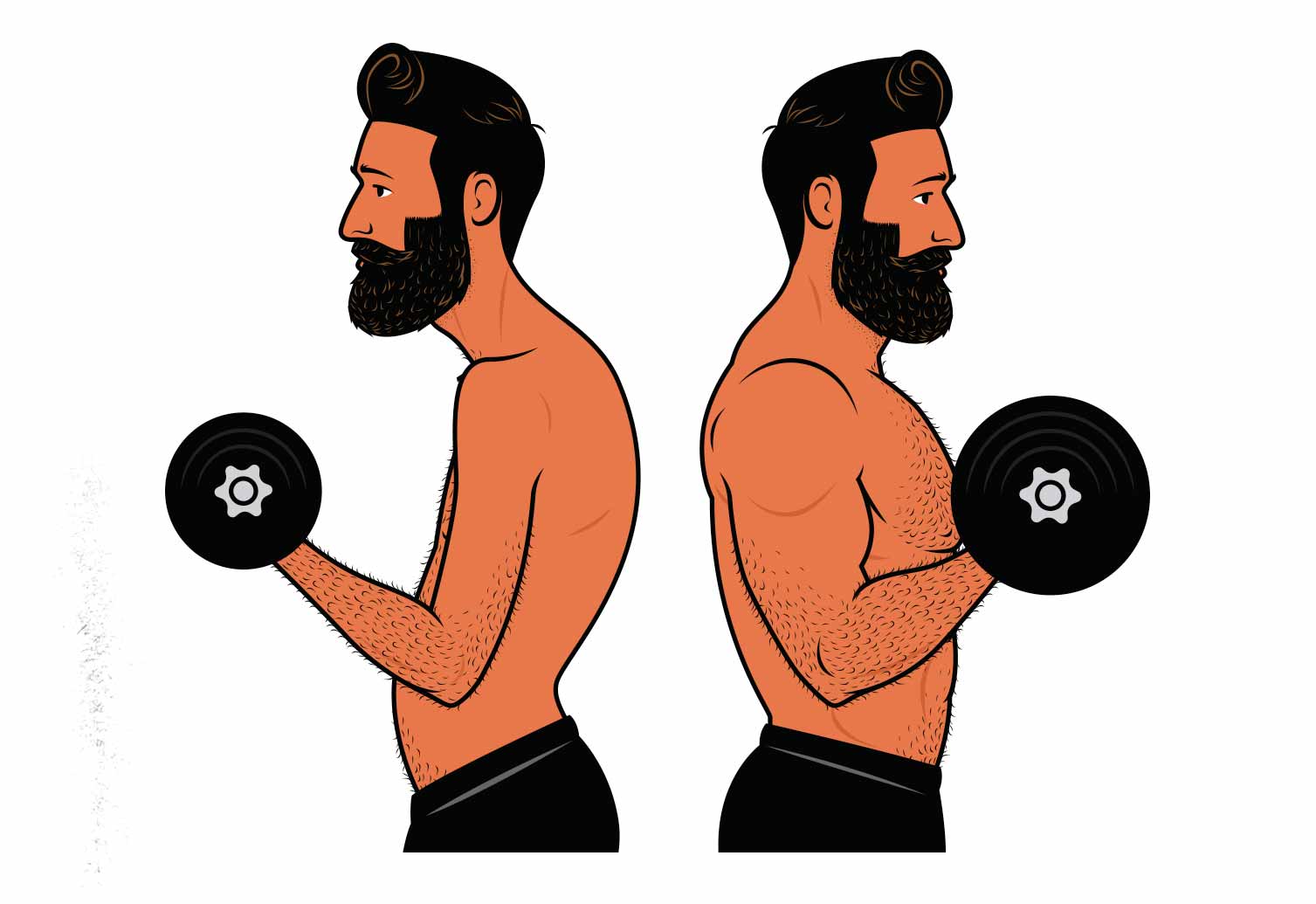
For example, you might want to start your workout by doing 4 sets of chin-ups, taking 2–5 minutes of rest between sets. Then you can move on to 3 quick sets of dumbbell curls, resting just 1–3 minutes between sets. Both of these exercises train your biceps and upper back, with the chin-ups placing more emphasis on your upper back and the curls putting more emphasis on your biceps.
Our muscles grow best when we train them at least twice per week, so maybe during another workout, you start with 4 sets of barbell rows followed by 3 sets of barbell curls. Both lifts are done in the same area with the same equipment, and so those 3 quick sets of biceps curls shouldn’t extend your workout by more than 5 minutes.
- Monday: 4 sets of As Many Reps As Possible (AMRAP) chin-ups + 3×12 biceps curls
- Friday: 4×15 barbell rows + 3×8 barbell curls
And there you have it. Combine these hypertrophy training principles with a good bulking diet, and you’ll have bigger biceps in no time.

If you want a customizable workout program (and full guide) that builds on these principles, check out our Outlift Intermediate Bulking Program. Or, if you’re still skinny or skinny-fat, try our Bony to Beastly (men’s) program or Bony to Bombshell (women’s) program. If you liked this article, you’d love our full programs.



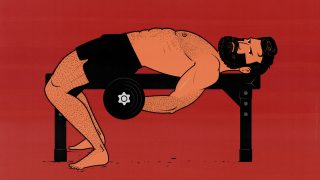

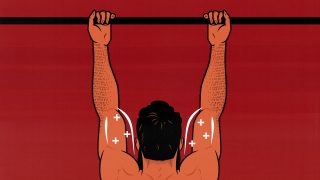
Enjoyed the article. Given your findings, why do you suppose Vince Gironda swore by drag curls?
Thank you, David!
You’ll find people who swear by all kinds of things, and sometimes those people are quite successful. The trick is figuring out whether the things they swore by actually contributed to their success. In this case, doing drag curls is certainly better than doing any biceps curls. It may even be enough to fully develop our biceps, given enough time and effort. From what I can gather, though, he seemed to recommend a slew of biceps exercises, ranging from preacher curls to cable curls to dumbbell curls to spider curls.
Vince Gironda was a bit of a contrarian with his bodybuilding practices, too. For instance, he advocated for a low-carb bodybuilding diet, cautioned against squats, and recommended the guillotine press instead of the bench press. And all of that’s okay. You can still build muscle that way. I think it shows that people can see tremendous success in spite of doing a few things that aren’t quite ideal.
Good points – no one “right way”, but certainly a “generally optimal” set of principles, I suppose. Thanks for the response.
Oh, and I wanted to add that I had always assumed the extremely strong contraction I felt when doing a drag curl was a good thing – and perhaps it is to an extent – but your explanation for why the deepest possible stretch is so important was eye opening.
Yeah! That’s one of those weird lifting things. When we focus on lifts that give us a great contraction, we get a huge pump and feel a great connection with the muscle. It FEELS like we’re stimulating a ton of muscle growth. Fast forward a day or two, though, and the muscle soreness tends to be lesser.
If we focus on training our muscles under a deep stretch, we get more of a “tearing” feeling at the bottom of the lift. Think of how your chest feels at the bottom of a bench press or your hamstrings at the bottom of a Romanian deadlift. The pump might not be as extreme. It might not feel as productive in the moment. But the fatigue and soreness tend to be quite a bit more pronounced, and it stimulates way more muscle growth.
Great explanation. Funny how we fall for our own smoke and mirrors without realizing it. Keep up the good work and thanks again.
Hey Shane,
Thanks so much for the detailed explanation. I just started Phase 2 and completely changed my diet, adding about 500 cal, and while I have seen some weight gain and certainly some strength gain, progress has been very slow with my biceps. So I was excited to read what you had to say, here.
I’m wondering, however: let’s say I’m in Phase 2, and each day already has one or two bicep exercises built in (Day 1, for ex, has Dumbbell Curls, while Day 3 has Chin Ups). Do you recc adding two sets of dedicated bicep exercises IN ADDITION to this exercise, such as, say Barbell Rows and Barbell Curls (or Chin-Ups and Dumbbell Rows, depending on the day), or for days in which there’s already a bicep exercise, should you only add one other exercise? I.e. if I’m on Phase 2, Day 1, would I add, say, Chin Ups and Hammer Curls, since there’s already Dumbbell Curls, or is this overdoing it?
I’ve been having trouble building this muscle for years — even now during the program, having added calories to my diet and followed the program to the T — and would love your insight here. I feel like I haven’t been pushing this muscle group enough with dedicated exercise and progressive overload, but I also don’t want to overdo it. Thanks so much for your time.
Hey Oren, my pleasure! I hope you’re liking the program 🙂
Outlift is built to have a good amount of arm work by default. It already includes a mix of compound and isolation lifts for your biceps and triceps, so you’re already following the principles laid out in this article. If you wanted to further emphasize your arms, though, you could use the last lift of each workout for that. Or you could add to the sheets, adding biceps curls to a day that doesn’t have them already.
Also keep in mind that your triceps are about twice the size of your biceps, so if you want to add size to your arms, there’s a big opportunity back there.
My arms have always been stubborn as well. I feel ya.
Hey Shane,
Appreciate the quick reply! I just realized, however, that I guess we’re referencing two different programs — I came to this article from an email through my Bony to Beastly account, not via Outlift, which I actually hadn’t heard of until now! Do you still recommend the same thing? I’m on Phase Two of B2B.
Oh! Sorry. I figured since you didn’t mention which program you were doing, you were talking about our Outlift program—our intermediate bulking program.
I don’t think you need to add anything to Bony to Beastly—our bulking program for skinny guys. As with Outlift, it already builds these principles in. And it’s already got quite a lot of biceps work. But the same advice applies. If you want to add even more, you can add 2 sets of biceps curls to the days without biceps curls 🙂
Understood – thanks, Shane!
Hello, first of all, congratulations on your articles. I have been following you for a long time.
I have a question!!! Should a row count for half a set for the biceps? Or otherwise, should a flat bench be counted as a half set for shoulders (front delt) and triceps? or everything must be counted?
Thank you!
Hey Marco, thank you!
If you wanted a rough rule of thumb, you could count the compound lifts as half a set for the muscles they don’t work that well. So with a row, count that as a full set for your upper back muscles, but only half a set for your biceps. The long heads of your biceps aren’t made to flex your arms while also flexing at the shoulders. They can’t fully engage. So half a set. With a flat bench press, count that as a full set for your chest (or at least your mid/lower chest), but only count it as half a set for your triceps. Same reason.
Your front delts CAN work fully in the bench press, though, especially on heavier sets. Like your chest, they flex just one joint. There’s no interference. They’re able to fully engage. But it really depends on the person. For me, the bench press barely works my shoulders at all. For others, the bench press works the shoulders more than the chest. I’d pay attention to what burns, what gets a pump, what gives out during the exercise, and what gets sore afterwards.
Instead of counting volume, though, what I usually like to do is pick a good exercise for each muscle, and make sure I’m doing at least 3 sets of that exercise in a workout. So for the chest/shoulder/triceps example, I might do 3 (or more) sets of bench presses for my chest, then 3 sets of skull crushers for my triceps. Later that week, I might do incline bench presses for my front delts and upper chest, following that up with some lateral raises for my side (and rear) delts. That way every week, I’ve got some ideal exercises for each of those muscles.
The reason I prefer the latter approach is that counting half a set lacks a bit of nuance. For your biceps, doing 6 sets of rows is not the same as doing 3 sets of biceps curls. The rows will only work part of your biceps, and might never bring them all that close to failure. The biceps curls will work both heads and will bring them as close to failure as you like. I think the best results come from combining both, not just aiming at a certain number of total sets.
I hope that makes sense. I know I’m overcomplicating things. You don’t need to be THAT detail-oriented with your workouts, especially if you’re just trying to gain overall muscle mass. But these are the things I keep in mind when writing programs.
Thank you very much for your answer. So, counting the sets complicates my planning. But I will keep in mind your speech about counting half sets for secondary muscle groups. I can’t wait for more articles to come out, especially those about “how to build bigger _.” I am learning a lot. You are doing a great job.
Hi Shane,
I broke my arm a few months ago and still lack the range of motion to fully suppinate that arm, eliminating the possibility of chinups and biceps curls.
Will neutral-grip pullups and hammer curls be sufficient for biceps hypertrophy until I gain back full suppination?
Thanks!
Hey Spencer, oi! Neutral grip lifts aren’t as good for challenging your biceps. You’ll probably work your brachialis proportionally harder that way. But it might be enough to bulk up your biceps anyway. It’ll depend. For me, my biceps are stubborn enough that if I don’t supinate, they don’t grow. But I’ve been training for many years now. If your biceps aren’t as stubborn or as close to their genetic potential, they’ll grow more easily and with a wider variety of movements 🙂
Either way, neutral-grip chin-ups and hammer curls will make your arms (and back) stronger and better-looking, even if they aren’t specifically bulking up your biceps.
I hope your arm heals up well!
Hi Shane, just wanted to drop a note and say what you are doing is awesome. In the 80’s I was one of those skinny kids. 6’4″ 170 lbs. I have always been on the quest for size. Your website is the closest to how I succeeded, just wish I would have had it 30 years ago. Consistency was biggest in my success. 6’4″ 300. Anyone who is following you will succeed. Oh yeah I’m 52 now. Still have the obsession! Keep up the great work!
Thank you so much, Chad! That means a lot.
Congrats for sticking with this for so long! That’s an inspiring goal for us younger dudes to work towards 🙂